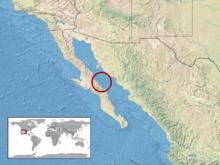Kingdom Animalia Suborder Serpentes Subfamily Crotalinae Scientific name Crotalus tortugensis Higher classification Rattlesnake Order Scaled reptiles | Subphylum Vertebrata Family Viperidae Genus Crotalus Phylum Chordata Rank Species | |
 | ||
Similar Crotalus transversus, Crotalus pusillus, Crotalus intermedius, Crotalus lannomi, Rattlesnake | ||
Crotalus tortugensis is a venomous pit viper species found only on Tortuga Island in the Gulf of California. No subspecies are currently recognized.
Contents
Description
This species is smaller than its close relative, C. atrox, with large males not growing to much more than 100 cm (39 in) in length. The largest specimen on record is 105.8 centimetres (41.7 in) (Klauber, 1972). Compared to C. atrox, the head is shorter relative to the length of the body—a trait considered to be an indication of dwarfing, which is common in island populations.
The color pattern consists of a gray to gray-brown ground color, occasionally with a slight purplish or pinkish hue, overlaid dorsally with a series of 32-41 dark brown to purplish-brown blotches running down the length of the body. The blotches are hexagonal or diamond-shaped, marked with black spots, and bordered with irregular black mottling.
Geographic range
Found only on Tortuga Island, Baja California Sur, in the Gulf of California, Mexico. Its type locality is "Tortuga Island".
Habitat
It lives in barren, rocky, desert terrain, sparsely covered with brush and cacti.
Conservation status
This species is classified as "Least Concern" on the IUCN Red List of Threatened Species. The population trend was stable when assessed in 2007. Species are listed as "Least Concern" due to their wide distribution, presumed large population, or because they are unlikely to be declining fast enough to qualify for listing in a more threatened category.
However, this species is threatened due to its limited range, though it is common on the island.
Behavior
Although Van Denburgh reported they would rattle vigorously when approached, they have been described as being less excitable than C. atrox, their mainland relative.
Feeding
Its diet apparently consists of mice. Several specimens from the island are reported to have contained mammal hair, and a white-footed mouse, Peromyscus dickeyi, is common on the island.
Venom
Klauber (1956) gives an average venom yield of 56 mg for this species. For comparison, the same study yielded an average of 277 mg for C. atrox.
Taxonomy
Though most recent authors consider this taxon to be distinct, it may actually be conspecific with C. atrox.
